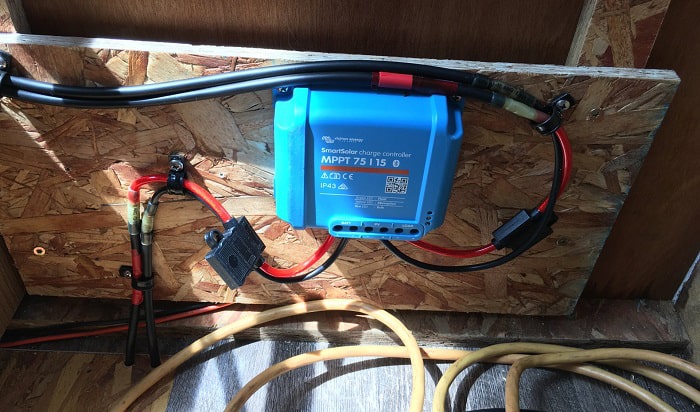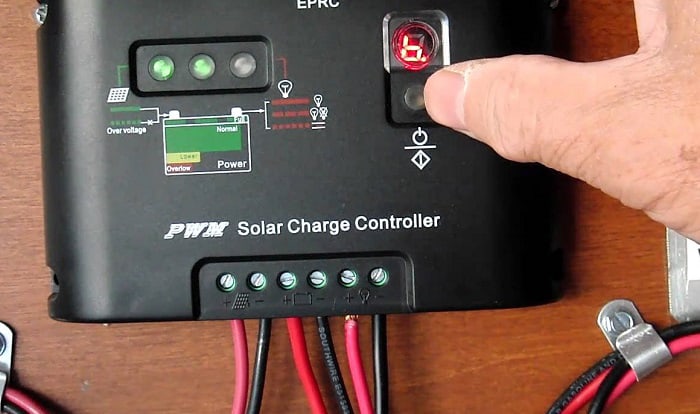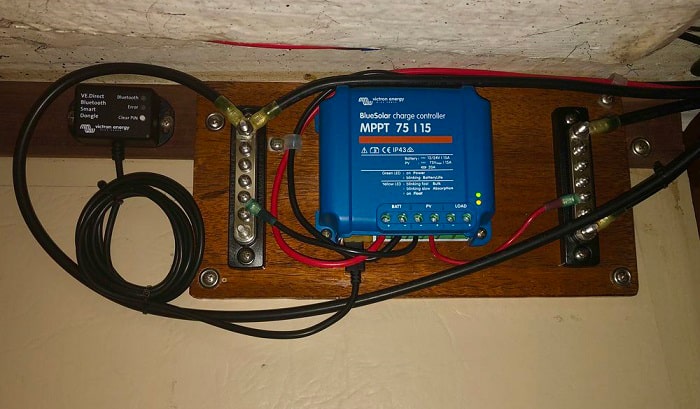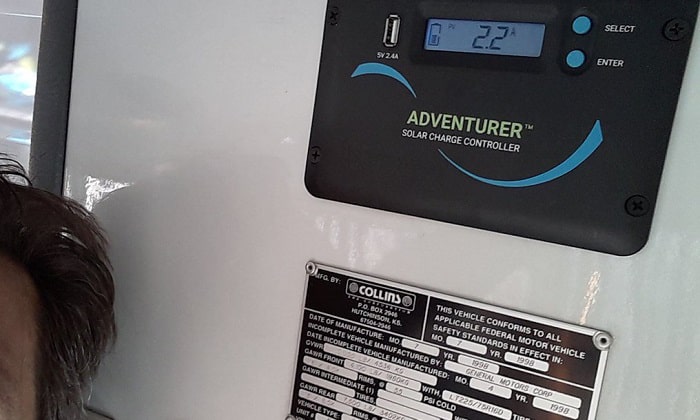When it comes to installing a solar charge controller in your RV, you are blitzed with a plethora of options. While a good thing, the abundance of choices also make the decision-making process more perplexing.
MPPT and PWM are two prominent choices in the market. So which one to choose? In this comprehensive guide, we will help you to understand both the technologies and eventually make a well-informed decision.
Table of Contents
What Is a Solar Charge Controller And the Need for It?
Similar to the CPU, the solar charge controller is the brain of your solar power system. It is responsible for generating and regulating the voltage derived from the solar panel to prevent instances like overcharged batteries or boiled dry in wet cell batteries.
These controllers are used to provide multiple stages of battery charging similar to the 110 volt AC chargers integrated into the RVs. While solar panels are sized by the watt, amps are used to size the solar charge controllers. The higher the amp, the costlier the solar charge controller. The solar charge controller is included when a solar power generating system is already integrated into the RV.
How Does a Solar Charge Controller Operate?
Typically, a charge controller passes current through a semiconductor that works as a valve to control the flow of the current. These controllers reduce the energy flow to the battery after it has reached a particular voltage level, thereby preventing batteries from being overcharged.
Batteries, when overcharged, can become damaging. Therefore, investing in a good solar charge controller is a must. Below are some essential functionalities of solar charge controllers that will help you better understand their needs:
- The controllers automatically disconnect the non-essential loads when the voltage drops beyond a particular threshold. Moreover, it also reconnects to the battery while being charged. This prevents over-discharging of the battery and protects the device from working at hazardously low voltages.
- Its most important function is to protect from overload. If the flow of current into the batteries is extremely higher than what the circuit can bear, the system may be exposed to overload. It can result in overheating or even cause fires. Solar charge controllers run to protect the occurrences of overload.
- Solar panels generate a current through the battery in a single direction. During the night time, these panels may pass the current in a reverse direction, resulting in slight battery discharging. A charge controller will act as a valve and protect the reverse flow of currents.
MPPT and PWM – Selecting the Right Solar Charge Controller for Your RV
The features embedded in these controllers vary based on the design and manufacturer. As mentioned above, there are two primary controller types used in the market today – Maximum Point Power Tracking (MPPT) and Pulse Width Modulation (PWM).
Maximum Point Power Tracking
Maximum Point Power Tracking or MPPT is the latest technology that amalgamates the valuable features of a PWM controller with more advanced functionalities. The PWM controller connects the solar panel and battery directly with each other.
MPPT, on the other hand, leverages a DC to DC buck converter prior to the PWM charging stage. The converter is responsible for collecting the voltage from the solar panel and converting it to the maximum power point.
Moreover, the MPPT charge controller comes with a pre-installed algorithm centered on a microprocessor. It scans or tracks the solar panel to determine the most optimized current between the solar panel and battery.
Benefits of Maximum Point Power Tracking
Maximum Point Power Tracking operates at around 94% to 98% efficiency rate, making it a more affordable option, especially on larger systems. It is capable of providing 30% more battery power in winter when the panel is working at its optimum level. Additionally, MPPT controllers come with higher compatibility.
Whether you opt for a 36-volt model or 24-volt model, these controllers will be able to provide good performance. However, you have to ensure that the size of the solar panel and the voltages are proportionate for the tracking feature to work properly.
Using higher voltage solar panels enable you to wire in series or parallel. That means more cost-efficient in comparison to the 12-volt models. Such an option allows you to leverage higher panel flexibility. Most of the MPPT controllers today offer four-stage battery charging.
Additionally, the Maximum Point Power Tracking can be sized above 80 amps, thereby providing higher flexibility for system expansion.
Challenges of MPPT Charge Controller
One of the primary concerns associated with the MPPT charge controller is the high cost. It costs three to four times as opposed to the PWM controller. However, the benefits clearly outweigh the challenges here.
Pulse Width Modulation or PWM
PWM is a straightforward and functional design that operates by transmitting a series of variable duty cycle pulses to a rapid “on-off” switch. Additionally, the controller regularly monitors the battery’s status and automatically adjusts the charges pulses of the battery.
The duty cycle falls off, nearly to 99% once the battery is fully charged. Contrarily, when the battery is discharged, the battery will continue to remain “on” 99% of the time. PWM is used in a solar charge controller that uses 12-volt solar panels wired in parallel within the solar power system of the RV.
Advantages of PWM Charge Controller
The PWM charge controller’s primary advantage is that it is designed on a proven and time-tested technology. This single unit is inexpensive and capable of efficiently handling 25 amps in less than $100. PWM charge controllers also rank high on the durability factor.
You can find PWM charge controllers in different size variants up to 60 amps and can be easily installed in standard solar systems used in an RV. Generally, these controllers offer three-stage battery charges; however, the most powerful option also provides users with five-stage battery charging.
Drawbacks of PWM Solar Charge Controller
Considering the controller directly connects the solar panel and battery, this results in certain flaws. To begin with, it reduces the voltage generated by the solar panel, thereby lowering the availability power.
Additionally, the pulses can develop interferences in your TVs and Radios. This happens because the frequencies used by the charge controller is lower in comparison to the higher frequencies of the MPPT controller.
Key Differentiating Points
1. System Size
If you are using a low power system, it is better to use a PWM charge controller as it offers constant harvesting efficiency, irrespective of the size of the array. Additionally, it is less expensive than MPPT, making it perfect for a small system.
2. Array to Load Ration
When the solar array is significantly higher as opposed to the power derived from a load of batteries, the latter will be in the full charge state. In such cases, PWM can efficiently manage the system. So there is no need to buy an expensive MPPT controller.
3. Temperature
An MPPT charge controller is ideal for colder conditions. When the temperature of the operating module decreases, the Vmp1 ameliorates. This is because the voltage of the solar panel working at Standard Testing Conditions peak point is around 17V, whereas the voltage of the battery stands approximately 13.5V.
Subsequently, an MPPT controller can capture the excess voltage module and use it to charge the batteries. This is the reason why an MPPT controller is able to generate 20-25% more charging in colder conditions in comparison to the PWM controller.
4. Solar Module
The stand-alone, off-grid modules are compatible with MPPT as well as PWM controllers. However, some grid-tie modules do not imbibe the standard 36-cells modules that work with off-grid power systems. In such grid-tie modules, MPPT technology proves to be more efficient than the PWM technology.
5. Cost
MPPT is a more expensive technology than PWM. However, it is also capable of offering more efficient performance in certain scenarios. For instance, it can produce more power without increasing the solar modules.
This is something the PWM charge controller is not capable of performing, but this technology works efficiently in other scenarios. So the cost becomes a less important factor when determining the usability of these two technologies.
Conclusion
A solar charge controller, irrespective of the type, is an important element of a solar system installed in your RV. By maintaining the efficiency and safety of storage batteries, the technology provides a high return on investment. When it comes to choosing between MPPT and PWM controller you should consider –
- The kind of solar panel you have installed.
- The level of usage you have with the solar panel.
- Cost your are willing to invest without compromising on the quality of the product.

Hi, I am Tom Hank, an RV-er since 2014. Back then, I started without much help. As you can imagine, the struggles are endless. But now, you do not have to begin your adventures knowing next to nothing about RV lives.





